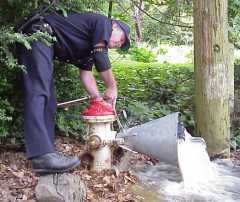 Regular hydrant testing is a significant component of the district's water supply
program. Water systems are constantly being impacted by improvements, deterioration,
changes in usage, and even water district maintenance activities which may affect zone valve settings.
As a result it is important to periodically test all fire hydrants to determine what
their capabilities would be in an emergency.
Regular hydrant testing is a significant component of the district's water supply
program. Water systems are constantly being impacted by improvements, deterioration,
changes in usage, and even water district maintenance activities which may affect zone valve settings.
As a result it is important to periodically test all fire hydrants to determine what
their capabilities would be in an emergency.
In addition to determining fire flows, testing can uncover a number of mechanical
problems from valves that don't operate properly to leaks and even pump damaging
debris flowing from hydrants. It is imperative that we discover problems and
get them repaired before the hydrant is needed in an emergency.
Flow test data also provides necessary field information so that water service planners
and the Fire Prevention Bureau can accurately estimate the capabilities of water mains.
Water main and hydrant flow capabilities impact decisions as to what fire protection
and fire resistance features are required for new developments and where priorities
should be placed with respect to upgrading older, smaller water mains.
It is the objective of the district's Water Supply Program to test
1/3 of the district's hydrants each year (in addition to annual service inspections
of all hydrants.)
|